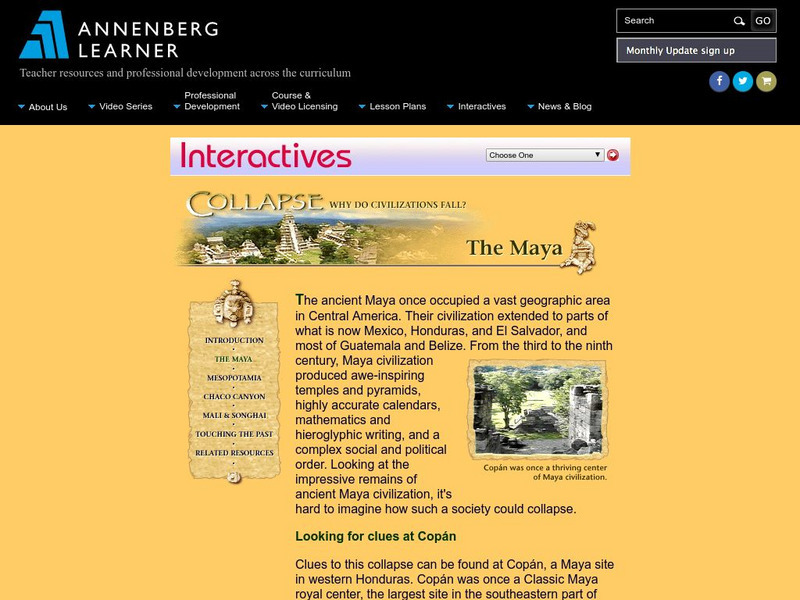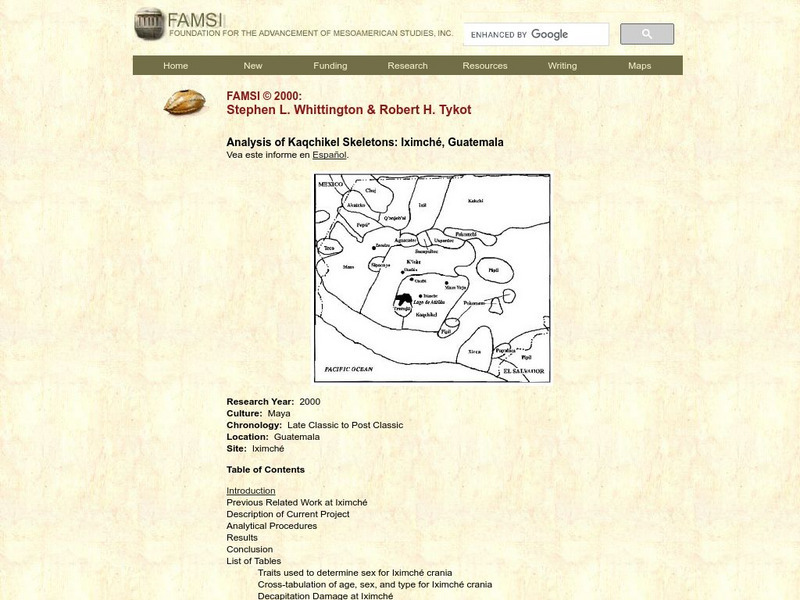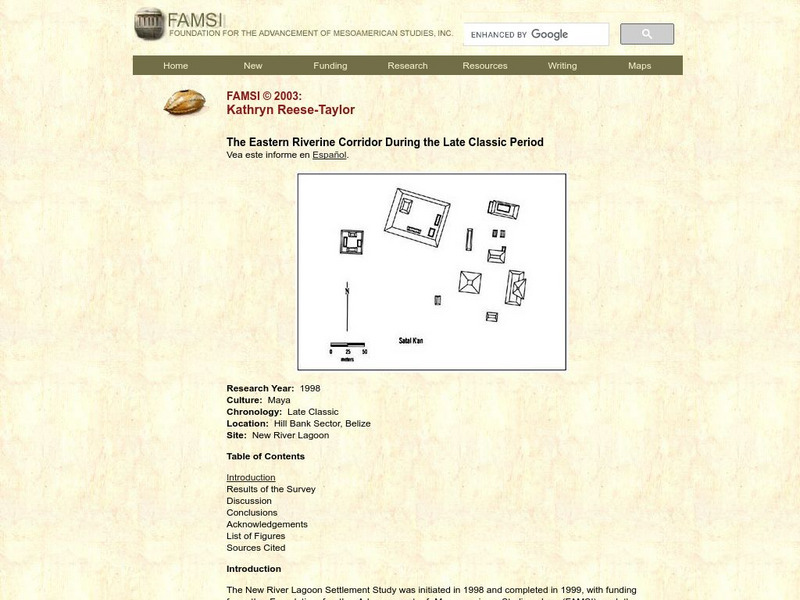PBS
Pbs Nova: Reading Maya Hieroglyphs
Part of a larger site from PBS on Mayan culture, this page refers specifically to the Mayan form of writing through hieroglyphs.
Foundation for the Advancement of Mesoamerican Studies
Famsi: Map of Maya Area
Map shows the locations of Mayan sites in Belize, El Salvador, Guatemala, Honduras and Mexico.
Other
Mesoweb: Rubbings of Maya Sculpture
This site is a personal account of an artist's trip to do Mayan rubbings. Includes images of the rubbings.
Fundación Cientec
Modelos Matematicos Del Cosmos De Los Indigenas Mayas Precolombinos
This site explains the Mathematical models used by the Mayan. You can see the traditional designs that Indians were using in their paintings and ceramic in the search for their calendars, their models of the cosmos and their mathematical...
EL Education
El Education: Meet the Maya
After researching ancient and contemporary Mayan culture, students each write and illustrate a page to add to a class alphabet book.
Lin and Don Donn
Lin and Don Donn: Maya Empire for Kids: Daily Life
A history teacher shares ideas as well as lesson and unit plans for teaching about the Mayans.
Curated OER
Mayan Monuments and Rubbings
A series of photos and rubbings from Mayan stone calendars and standing stones (stelae) that could be used as primary sources for a unit on Mayan history.
Curated OER
University of St Andrews: Mayan Mathematics
This site from the University of St. Andrews provides indepth information about the mathematics of the Mayan civilization, and shows just how advanced they were.
Annenberg Foundation
Annenberg Learner: Collapse: Why Do Civilizations Fall?
Why did great civilizations fall? War, disease, overpopulation or natural disasters? Interactive content and activities allow you, by sifting through archaeological evidence, to investigate the collapse of the Mayan civilization, the...
Annenberg Foundation
Annenberg Learner: Collapse: The Maya
Captivating site containing information about the collapse of civilizations. It explores the needs and characteristics of a healthy civilization that must be maintained in order to avoid collapse.
Curated OER
Vessel 8, Tomb 2, Chan Chich, Belize
Excavation of tomb indicates the occupant was elite as indicated by wooden snake. Several Mayan artifacts are pictured.
Curated OER
Figure 3. Palenque's Subterranean Palace Aqueduct.
Study indicates that Palenque aquaducts were part of city planning and suggests reasons that Mayans would choose the existing plan. Many photographs of the aquaduct are included.
Curated OER
Wikipedia: Maya Architecture
This article covers Mayan urban design, types of structures and building processes.
Foundation for the Advancement of Mesoamerican Studies
Famsi: Analysis of Kaqchikel Skeletons: Iximche, Guatemala
Report of structural and chemical analysis of skeletal items offers insights into human sacrifice procedures and diet.
Foundation for the Advancement of Mesoamerican Studies
Famsi: Economic Foundations of Mayapan Project (2001)
Although this excavation is still in progress, preliminary reports indicate occupants produced pottery for local and regional consumption. Also the production of tools and jewelry depended on materials from other parts of the region.
Foundation for the Advancement of Mesoamerican Studies
Famsi: The Eastern Riverine Corridor During Late Classic Period
Inventories of ceramic materials and architectural similarities indicate that some urban centers may be socially and politically connected while others are not. Study confirms a water route from New River drainage area to Belize may have...
Foundation for the Advancement of Mesoamerican Studies
Famsi: The Pomona Kingdom and Its Hinterland (2001)
Pomona Kingdom was contested by Palenque and Piedras Negras and fell under attack several times. A preliminary interpretation of findings allows for a reconstruction of how attacks might have occurred.
Foundation for the Advancement of Mesoamerican Studies
Famsi: Northern Belize Coastal Project, 1999
Archaeological investigations at Saktunja site in Belize focuses on inter-region trade networks and diversification strategies. Site can be viewed in English and Spanish.
Foundation for the Advancement of Mesoamerican Studies
Famsi: Temple 22 Facade Reconstruction Project (2001)
Preliminary research indicates that structure was a sacred mountain used as a political center. Discussion of sculpture meanings is included.
Foundation for the Advancement of Mesoamerican Studies
Famsi: Epi Classic Cultural Dynamics in the Mezquital Valley
Interesting study of artifacts used to demonstrate inter-regional trade in the Mezquital Valley area of Mexico during A.D. 600-1000. This work also offers good insights into specific cultures.
Foundation for the Advancement of Mesoamerican Studies
Famsi: Recording New Inscription of Palenque (1995)
Research reports includes an enormous amount of photographs and drawings of stucco hieroglyphs from various temples.
Foundation for the Advancement of Mesoamerican Studies
Famsi: 2001 Study of Labna Kiuic Archaeological Project
Goals of this study are to investigate reasons for the abandonment of the region, settlement patterns, and political organization of the Puuc region.
Foundation for the Advancement of Mesoamerican Studies
Famsi: Investigation and Conservation at San Bartolo (2002)
Excavation reveals murals in tunnels and earliest example of painted hieroglyphic script in Maya Lowlands.
Foundation for the Advancement of Mesoamerican Studies
Famsi: Plants of the Underworld: Ritual Plant Use (1998)
Details the use of plants in burial rituals based on findings during excavation at Actun Nak Beh, Barton Creek, Actun Chapat, and Actun Chechem Ha sites in Belize, Guatemala, Honduras, and El Salvador. Site can be viewed in English and...





















